Toy Bear You Can Draw on
Notes:
This lesson gives your students some important vocabulary to use in their daily lives. They will be able to identify some toys as well as count and describe them using colors.
IMPORTANT: This lesson plan reviews the colors so it should be taught after the Colors lesson plan. You will also need to have some classroom toys, in particular a teddy bear, a doll, blocks, a robot, a puppet, a book, a ball, balloons.
Lesson Procedure:
Warm Up and Maintenance:
See our "Warm Up & Wrap Up" page.
New Learning and Practice:
1. Play "Hide and Find"
Let's start off with a fun game. Before the class, hide the following toys around the classroom (under chairs, in bookshelves, etc.): teddy bear, doll, blocks, robot, puppet, book, ball, balloon. You can also add some more toys to this list if you wish. Also, make sure you have printed the same flashcards as the toys you have hidden. You will need at least one toy per student (if you have a lot of students you can use multiple blocks, balls and balloons, so that each student has at least one toy to find).
Have all of your students sit down. Give each one a toy flashcard and tell them that hidden around the room are some toys which they have to find. Model the activity, by showing one toy flashcard (e.g. a picture of a doll) - wander around the room looking in different places until you have found a toy doll. Now, let everyone get up and search around for their toy and then sit down again in their place with the toy.
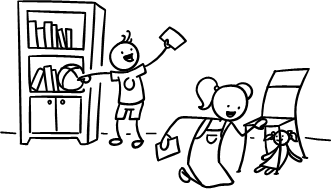
Once all the toys have been found go around the class and have each student hold up the toy they have found. For each toy say and chorus the toy word (e.g. Teacher: "a ball"; Students "a ball").
Next, collect up the flashcards and get each student to hide their toy again - but in a different place. Now, give out the flashcards again, but make sure each student has a different toy flashcard to the one they had before. Let everyone go off to search for their toy, and as before, chorus each toy once they have all been found.
You can play this game a few times but finish before your students start to lose interest.
2. Play "Shout it Out"
 Have all of your students sit down. Start by holding up each toy and eliciting, chorusing and passing the toy around (when passing make sure each student says the word for the toy as they pass it).
Have all of your students sit down. Start by holding up each toy and eliciting, chorusing and passing the toy around (when passing make sure each student says the word for the toy as they pass it).
Next put all of the toys in a box and have everyone close their eyes. Pull out a toy and say "Open your eyes" - everyone must open their eyes and shout out the word for toy that you are holding. Play this for all of the toys.
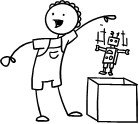 3. Play "Fetch it"
3. Play "Fetch it"
Throw all of the toys around the classroom and place the box at the front of the class. Say to one student "Please fetch the robot". That student gets up, goes to the robot, picks it up and takes it over to the box and drops it in. Then have a different student for another toy. Keep going until all of the toys are in the box.
4. Play "Musical Circle Touch"
Sit all of your students in a circle and place the toys in the center of the circle. Play some music on your CD player and have students pass a ball or bean bag around the circle. Stop the music. Say to the student holding the ball "Touch the teddy bear!" - and the student does so. Start playing the music and do the same thing so that all of your students have touched a toy.
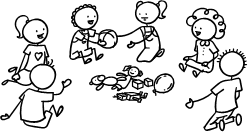
5. Play "Feel in the box"
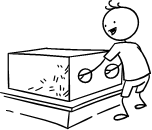 This is a fun activity. You will need a big box with two round holes two holes cut in it - big enough for your students to put their arms in. Get everyone to close their eyes as you put a toy in the upturned box. Model first: put your arms through the holes and feel the toy. Pull a face to show you are feeling something and don't know what it is. Then finally, look happy and say "It's a puppet!" and lift up the box to show everyone what you have found.
This is a fun activity. You will need a big box with two round holes two holes cut in it - big enough for your students to put their arms in. Get everyone to close their eyes as you put a toy in the upturned box. Model first: put your arms through the holes and feel the toy. Pull a face to show you are feeling something and don't know what it is. Then finally, look happy and say "It's a puppet!" and lift up the box to show everyone what you have found.
Let each student have a go. Also, a great idea is to also add some other objects that students have studied in a previous lesson (e.g. a crayon, plastic fruit, plastic animals, etc.) - this will add an element of surprise and allow for vocab review.
6. Review colors - Sing "The Rainbow Song"
Your students will have sung this song in previous lessons so they should be familiar with it. Play and sing the song with everybody pointing at colors as you sing (either colored origami, the song poster or colors on the walls around the room).
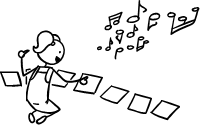 Lyrics for "The Rainbow Song"
Lyrics for "The Rainbow Song"
Verse 1: Verse 2:
Red and yellow and pink and green,
Purple and orange and blue.
I can sing a rainbow,
Sing a rainbow,
Sing a rainbow too.
Red apples and yellow sun,
Pink flowers in the green grass.
Purple grapes and orange carrots,
A rainbow high in the blue sky.
Verse 3:
Red and yellow and pink and green,
Purple and orange and blue.
I can sing a rainbow,
Sing a rainbow,
Sing a rainbow too.
(download MP3 here)
Gestures for "The Rainbow Song"
There are a number of activities you can do as you sing along to the song:
- Simply pat your knees or clap in time with the music as you sing the song.
- Give each student a print out of the Rainbow Song song poster. As they sing along they touch each color or picture.
- Give out the 7 colors to students (colored paper, origami paper, colored blocks, colored pencils – anything will do) and have students touch the colors in time with the song.
- Put colored paper up around the walls of the classroom. Have all of your students point to each color as it is sung.
We also have a video that you can stream in class to sing along with (Internet connection required):

7. Do the "Color Stickers" activity
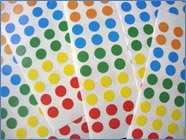 For this activity you need lots of colored sticker circles which can easily be found in most stationery shops. If you can't get hold of some, using colored crayons will also do.
For this activity you need lots of colored sticker circles which can easily be found in most stationery shops. If you can't get hold of some, using colored crayons will also do.
First, put up a large sheet of paper (ideally A3) on the wall with columns draw on it. At the top of each column draw a large colored dot - each column with a different colored dot. It should look like this:
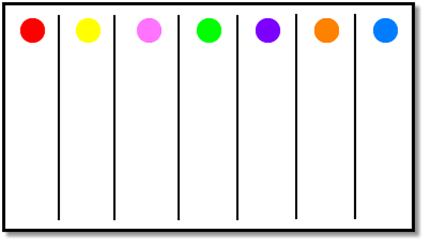
Quickly chorus through the colors on this sheet. Then give out a sheet of colored stickers to each student. Tell them they are going to look at all the toys and for each color they see they will go up to the poster and put a colored dot in the correct column (or draw a dot with their crayon). So for example, a student looking at a doll may see a pink dress, red shoes and green eyes, so s/he will go up to the poster and stick on red, pink and green dots. Then s/he will find another toy to put up colors.
Keep going until students have filled the sheet with dots. Get everybody to sit down and look at the poster. Talk about the colors and ask which color has the most and least dots.
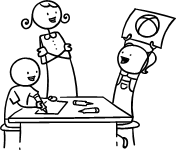 8. Do the "Fun with toys!" worksheet
8. Do the "Fun with toys!" worksheet
This worksheet carries on straight from the last activity (toys and colors). Give out the worksheets. For younger students who can't read, elicit the first toy (a teddy bear) and then read the sentence under the picture "a yellow teddy bear". Have everyone take out their yellow crayons and color the teddy bear picture. Carry on like this for all of the pictures. When finished, get each student to show the class their work, ask a question (e.g. what color is the doll?) and give a round of applause.
9. Read classroom reader "Toys Play Time"
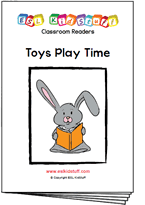 Now that the toys and colors vocabulary has been practiced we can move onto a fun, simple story which uses the target vocab. Before class, download and print off the reader "Toys Play Time". As you go through each page, point to the different toys and ask for the students to tell you what they are and what colors they see, for example:
Now that the toys and colors vocabulary has been practiced we can move onto a fun, simple story which uses the target vocab. Before class, download and print off the reader "Toys Play Time". As you go through each page, point to the different toys and ask for the students to tell you what they are and what colors they see, for example:
Teacher: (pointing on page 3) Look, what toy is this?
Students: A teddy bear!
Teacher: Yes, that's right! And what color is it?
Students: Brown!
Teacher: Yes, a brown teddy bear! And what is he playing with? (pointing at the balloon)
Students: A balloon!
Teacher: Yes, good job! And what color is the balloon?
Students: Red!
 Continue through the reader, eliciting different objects and colors.
Continue through the reader, eliciting different objects and colors.
After reading the story, give out a reader worksheet to each student and read through the story one more time (without stopping for questions, etc.) as students color the objects from the story. Check that everyone is using the correct colors.
---
Alternatively, watch our video version of the reader (Internet connection required):
10. Play "What's missing from the line up?"
Let's finish with a fun game which will review vocab from this lesson. Get everyone sitting down and place all of the toys in front of you in a line. Say "Close your eyes". Make sure everyone has their eyes closed and covered with their hands (model this so everyone can see what to do). Quickly take a toy away from the line up and hide it behind your back. Say "Open your eyes". Nod towards the space where a toy was and say "What's missing?". Encourage the students to shout out the answer.
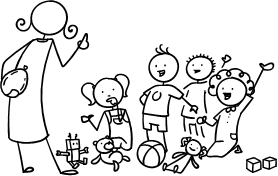
The first student with the correct answer can now take over. Have him/her come to the front of the class. Get everyone to close their eyes as the student selects a toy and hides it behind his/her back. Continue this game until everyone has had a go.
Wrap Up:
1. Assign Homework: "Toys Match and Color!" worksheet.
2. Wrap up the lesson with some ideas from our "Warm Up & Wrap Up" page.
Source: https://www.eslkidstuff.com/lesson-plans/toys.html
0 Response to "Toy Bear You Can Draw on"
Post a Comment